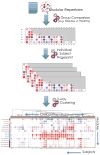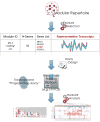Democratizing systems immunology with modular transcriptional repertoire analyses
- PMID: 24662387
- PMCID: PMC4118927
- DOI: 10.1038/nri3642
Democratizing systems immunology with modular transcriptional repertoire analyses
Abstract
Individual elements that constitute the immune system have been characterized over the few past decades, mostly through reductionist approaches. The introduction of large-scale profiling platforms has more recently facilitated the assessment of these elements on a global scale. However, the analysis and the interpretation of such large-scale datasets remains a challenge and a barrier for the wider adoption of systems approaches in immunological and clinical studies. In this Innovation article, we describe an analytical strategy that relies on the a priori determination of co-dependent gene sets for a given biological system. Such modular transcriptional repertoires can in turn be used to simplify the analysis and the interpretation of large-scale datasets, and to design targeted immune fingerprinting assays and web applications that will further facilitate the dissemination of systems approaches in immunology.
Figures






References
-
- Schuh W, Meister S, Herrmann K, Bradl H, Jack HM. Transcriptome analysis in primary B lymphoid precursors following induction of the pre-B cell receptor. Molecular immunology. 2008;45:362–375. - PubMed
Publication types
MeSH terms
Grants and funding
LinkOut - more resources
Full Text Sources
Other Literature Sources
Medical
Miscellaneous

